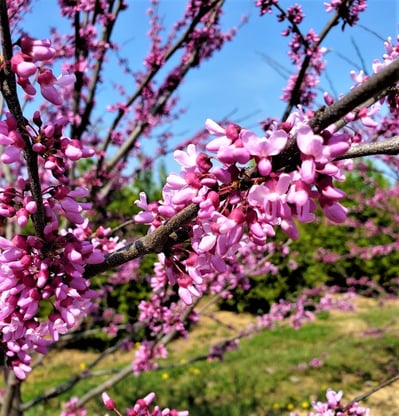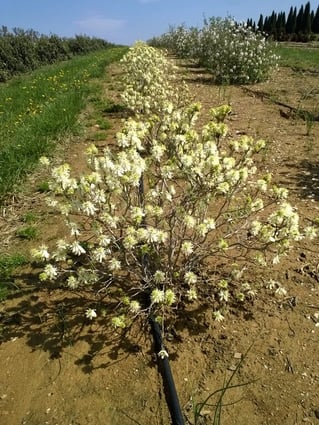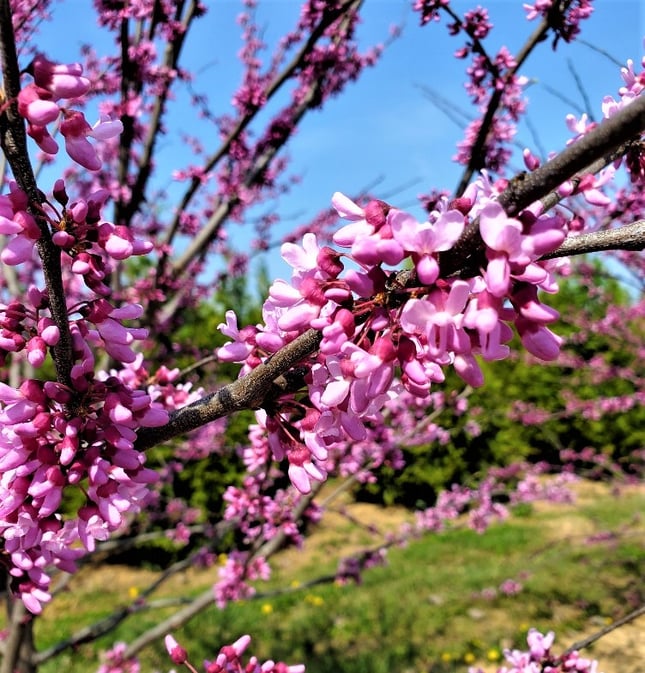Once the weather begins to warm, I start looking for signs of shrubs and trees that are beginning to bloom. Two of my favorite early spring bloomers are Cercis and Fothergilla. The pink haze on the Cercis branches and the white cloud of bottle brush flowers on Fothergilla are two of the earliest signs that spring is on its way at Waverly Farm. In celebration of these spring beauties, read on for some interesting facts.
"Blossom by blossom the spring begins."
-- Algernon Charles Swinburne
Cercis canadensis
Cercis canadensis or Eastern redbud is a small native understory tree in the wild and a wonderful addition to any landscape design. In early spring purplish-pink buds swell on the tree’s limbs and twigs and eventually open to pea-shaped flowers that provide color for up to three weeks. After the flowers are almost spent, heart-shaped leaves begin to emerge. In fall, its leaves turn yellow providing fall color. The zigzag growth pattern of the branches adds winter interest.

- Plant Type: Deciduous flowering tree
- Zones: 4-9
- Height: 20-30 feet
- Spread: 25-35 feet
- Foliage: green in summer turning yellow in fall
- Flowers: purple-pink buds and flowers during March and April
- Light: Full sun to partial shade
- Water: Medium, prefers well-drained soil
- Uses: Specimen plant, naturalized settings
- Benefits: Early spring color, four-season interest, deer resistant
The genus name, Cercis is derived from the Greek word for weaver’s shuttle because its seed pod resembles the size and shape of a weaver’s shuttle. Cercis sometimes is called a Judas Tree because mythology has it that Judas hanged himself on a redbud tree after betraying Christ. As the myth goes, the flowers that were originally white turned pink with shame. This was, however, not our native Cercis canadensis, but another species, Cercis siliquatrum, found in the Middle East.
Cercis can adapt to a wide range of conditions but prefer at least four to six hours of light daily. Trees in full sun will bloom more profusely.
Cercis works well as a specimen plant or planted in groupings against evergreens to highlight the early spring flowers. Additionally, they do well planted on a hillside to control erosion. The flowers are edible and make a particularly nice and colorful addition to salads. A pink and tasty simple syrup is easily made from the buds and flowers.
Although not requiring huge amounts of maintenance, Cercis will benefit from annual pruning to remove dead wood, crowded or crossing branches, and weak forks. Prune after flowering or in late fall when the tree is dormant.
The straight species is lovely, but its varieties and cultivars can be showstopping. We also grow Cercis canadensis ‘Forest Pansy’ with fuchsia flower. The leaves emerge after the flowers in a deep purple color that greens through summer and reddens again in fall. Cercis canadensis var. alba is much like the straight species but with white flowers.
Fothergilla major ‘Mt. Airy’
Fothergilla major ‘Mt. Airy’ or mountain witch alder is a shrub providing four-season interest. In early April, before the leaves emerge, Fothergilla major ‘Mt. Airy’ blooms with an interesting white bottlebrush-form flower. The flowers have a sweet fragrance, vaguely reminiscent of honey, and persist for two to three weeks. Its leaves are green and have a quilted appearance. In fall, the leaves turn shades of golden yellow, orange, and red and remain on the branches well into November. Like Cercis, Fothergilla follows a zigzag growth pattern creating winter interest.

- Plant Type: Deciduous flowering shrub
- Zones: 5-8
- Height: 3 – 5 feet
- Spread: 3 – 5 feet
- Colors: bluish-green foliage in summer; yellow, orange, and reddish purple in fall
- Flowers: Honey-scented bottlebrush-like white spikes during April.
- Light: Full sun to partial shade
- Water: Medium (adaptable to various moisture conditions)
- Uses: Low hedge, border planting, foundation plantings
- Benefits: Deer resistant, little pruning, shade tolerant
The genus name, Fothergilla honors Dr. John Fothergill, an 18th century English physician and hobby botanist. He was good friends with Benjamin Franklin and introduced many native American plants to his large botanical garden in England. The specific cultivar Fothergilla major ‘Mt. Airy’ was discovered at the Mt. Airy Arboretum in Cincinnati, OH by Dr. Michael Dirr and is a cross between Fothergilla gardenii and Fothergilla major.
Related to Witch Hazel (Hamamelis) and native to the southeastern U.S., Fothergilla prefers sun unless it is in hot and humid climates. If pruning is necessary, low-maintenance Fothergilla is best trimmed after it flowers. To maintain a shrub-like form, remove any suckers.
Fothergilla can be used in a variety of settings including specimen plantings in cottage gardens, foundation plantings, part of a mixed border, as an informal hedge, and naturalized in a woodland garden setting.
We currently have both plants in stock. You can call or email us with your order, shop online at our website, or shop our availability via Landscape Hub.






